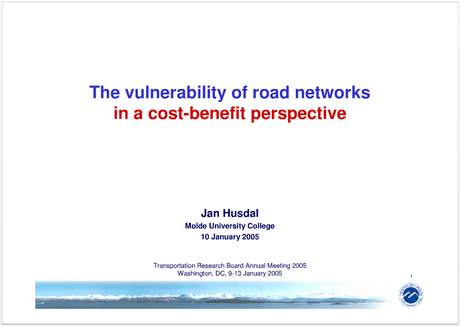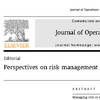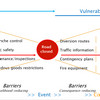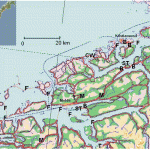 A reliable transportation network represents a net benefit to society, and conversely, a vulnerable network represents a net cost to society. Hence, vulnerability ought to be an important parameter for decision-support in cost-benefit analyses, in order to establish a link between the terms reliability and vulnerability vis-à-vis costs and benefits. A multi-criteria analysis approach is suggested as an appropriate methodology for analyzing the monetary and non-monetary effects of vulnerability. Looking beyond the science of vulnerability assessments, this paper discusses some of the network attributes that influence the vulnerability of transportation networks, influences that can be described as structure-related, nature-related or traffic-related attributes. The influences of the individual attributes are then examined as possible candidates for measuring of the vulnerability of the transportation network.
A reliable transportation network represents a net benefit to society, and conversely, a vulnerable network represents a net cost to society. Hence, vulnerability ought to be an important parameter for decision-support in cost-benefit analyses, in order to establish a link between the terms reliability and vulnerability vis-à-vis costs and benefits. A multi-criteria analysis approach is suggested as an appropriate methodology for analyzing the monetary and non-monetary effects of vulnerability. Looking beyond the science of vulnerability assessments, this paper discusses some of the network attributes that influence the vulnerability of transportation networks, influences that can be described as structure-related, nature-related or traffic-related attributes. The influences of the individual attributes are then examined as possible candidates for measuring of the vulnerability of the transportation network.
READ ONLINE
INTRODUCTION
Few will question that the sender, the recipient, the freight hauler, or society at large, experience additional costs when goods or people cannot reach their destinations in time or in space. Consequently, it should be obvious that a reliable transportation network represents a benefit to society. Equally, a vulnerable network would represent a net cost to society (1). Why then, is the reliability, or conversely, the vulnerability, of the transportation network not a matter of evaluation in traditional cost-benefit analyses? In the most common manner of speaking, the reliability of a transportation network can be defined as the probability that one or more of its links functions, or rather: does not fail to function, according to a set standard of operating variables. A non-functioning, or at best, badly-functioning link will impose costs on the user in terms of loss of time, additional operation costs or other costs as a result of delays and diversions. Transporters of perishable goods will also experience a loss of value. These are socio-economic costs that should be taken into consideration in cost-benefit analyses of transportation projects; yet, as a norm, reliability and vulnerability are not evaluated in today’s practice (2). This means that the evaluation of benefits of proposed new projects and the costs of using existing infrastructure may be lacking important elements.
Taking up the invitation in Berdica (3) to bring out and recognize the vulnerability in the road transportation system as a meeting point for all the different strands of transportation reliability research and other issues (p.127), the focal point of this paper is to look at a road network from a reliability and vulnerability perspective and to link this analysis to cost-benefit decisions. Looking beyond the science of vulnerability assessments, this paper discusses some of the network attributes that influence the vulnerability of transportation networks, influences that can be described as structure-related, nature-related or traffic-related attributes. The paper introduces vulnerability as a parameter for decision-support in cost-benefit analyses and seeks to establish a link between the terms reliability and vulnerability vis-à-vis costs and benefits.
First, the paper exemplifies why vulnerability should be an issue in road project evaluations or in determining public service locations. Second, it considers how the study of the vulnerability of transportation networks relates to traditional reliability analysis. Third, potential measures of vulnerability are briefly described and classified into three separate groups. Fourth, an attempt is made to establish a link between the terms reliability and vulnerability and the terms costs and benefits.
WHY MAKE VULNERABILITY AN ISSUE?
Transportation networks like freeways and interstate highways are the main backbone of modern society. Consequently, the reliability, or conversely, the vulnerability of any transportation network is thus a decisive factor not only in terms of market outreach and competition, but also in terms of continuity, to ensure a 24/7 operation of the community we live in. Any threat to the reliability of the transportation network constitutes a vulnerable spot, a weakness (4)(5).
This is of particular concern when considering sparse, rural networks, because what by urban standards is a minor degradation (i.e. car accident, resulting in queuing, delays and diversions) may have severe consequences if occurring in a rural setting (i.e. blocking the only access road for hours). From a user point of view, what matters most in relation to a transportation network is the following: Can I, at the desired time of departure, get from A to B by using the intended route and means of transportation, and arrive at a desired time, which would be the best case. Or, does there exist no route or means of travel at all that can take me from A to B at the desired time of departure, let alone within arriving at the desired time, which to the user would be the worst case.
Disruptions in a road network are often the result of external influences such as landslides, avalanches or rock fall, flooding, lack of snow clearing during winter, accidents that require extensive clean-up, etc.; the list of scenarios is literally endless. Intentional sabotage or terrorist attacks must also be included here, but are not a major scope of this paper. Often seen in Norway, closures of sub sea tunnels and failures or severe degradation of ferry services are also among the many factors that will occur depending on the season and location. Ferry services may be of no concern in some parts of the country, whereas rock fall can be a major issue in other parts. In the most common manner of speaking, the reliability of a transportation network can be defined as the probability that one or more of its links functions, or in better said, the probability that one or more of its links does not fail to function. Vulnerability, on the other hand, represents the network’s or the links’ susceptibility to failure, where the term failure here expresses a considerable deviation from the normal functioning state of the link or network.
A non-functioning, or at best, badly-functioning link will impose costs on the user in terms of loss of time, additional operation costs or other costs as a result of delays and diversions. Transporters of perishable goods will also experience a loss of value. These are socio-economic costs that should be taken into consideration in cost-benefit analyses of transportation projects; yet, as a norm, reliability and vulnerability are not evaluated in today’s practice. New transportation projects are seldom explicitly evaluated in terms of increased reliability or lessened vulnerability (6). Nonetheless, vulnerability assessments should be acknowledged as an integral element within the cost-benefit analysis that is part of any transportation planning process.
A perhaps myopic, but at the same time illustrative case from Norway may demonstrate why vulnerability should be an issue in the evaluation of transportation networks:
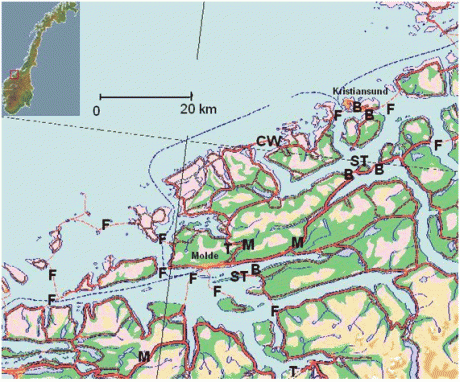
On the North-western coast of Norway (figure 1), there is a hospital in the cities of Molde and Kristiansund, 75 kilometers (47 miles) apart. In conjunction with a recent evaluation of whether one should maintain two separate hospitals versus establishing one hospital at a new location that would cover the service areas of both hospitals, a study was conducted to compare the travel times for employees, out-patients and in-patients for a set of locations. What is disturbing to this author, and which is the reason for his interest in the subject, is that the study exclusively used “ideal” travel time parameters, among which: Speed equal to speed limit, and a waiting time of maximum 15 minutes at the required ferry crossings. What from the point of this author is lacking is a consideration of a) seasonal variations of serviceability (snowy and icy roads versus clear roads), b) the possibility of ferry breakdowns due to engine failure, ferry delays or cancellations due to high winds and rough seas (a well-known event in coastal Norway), c) potential closures of the mountain passes that must be traversed in this example (a season-dependent and location-dependent issue), d) possible closure of a sub sea tunnel for certain travelers, e) closure of long bridge spans due to high winds, and f) avalanches and rock fall, to name but a few. The aforementioned are all known incidents along the studied routes. However, these factors were not considered. Admittedly, incorporating these factors is difficult, and in a statistical sense perhaps of no significance. Furthermore, ideal parameters are, after all, easier to use for a ceteris paribus comparison of travel times. Nevertheless, should the vulnerability of the transportation network not be part of the equation when locating critical public services such as hospitals? It is not the point here to advocate the use of worst-case scenarios; however, they should be part of the overall evaluation. In hindsight, it is usually better to have evaluated worst-case scenarios and discarded them if they do not have any influence, than actually to have to face a worst-case scenario and wonder why this had not been evaluated.
With this generally applicable example in mind, it may be surprising that the reliability of the transportation network still remains a factor that is only seldom looked at in economic impact assessments. For the most part, saved travel time is what drives the policy of the decision makers, increased reliability is as a rule not a subject for closer evaluation; it is mostly taken for granted as far as new projects are concerned. Introducing the reliability of the road network as a decision variable will thus bring new perspectives to cost-benefit analyses, where the question of whether travelers and goods indeed can traverse the network and thus arrive at their destination is given more weight than in traditional analyses. From a freight hauler’s point of view, a vulnerable network is a network that is easily disrupted, resulting in unpredictable stops and downtime. This is probably seen as a much larger problem than a congested and slow-moving network that is relatively reliable and stable. In the latter, there is at least some guarantee that the goods will arrive at their destination, and most important, the transportation costs, though annoyingly inefficient, are still calculable and lead times are still predictable.
RELIABILITY VERSUS VULNERABILITY
It seems fair to conclude that the current literature acknowledges reliability and vulnerability as being two related, yet different concepts. Both Berdica (3) and Taylor and D’Este (7)(8) lament the lack of a formal definition of vulnerability. Traditionally, when looking at the reliability of transportation networks, it is done with a systems engineering approach. Reliability is here an expression of the probability that links within the network will function, reliability may thus be viewed as the degree of stability of the quality of service that a system offers.
In Bell and Iida (9), transportation network reliability is focused on connectivity reliability (also named terminal reliability) and travel time reliability. Nicholson et al. (10) in addition list and discuss encountered reliability, capacity reliability and flow decrement reliability as ways of measuring reliability. Whereas probability or predictability is a major concern in network reliability studies, the impacts or consequences of disruptions are the main focus of vulnerability studies (11).
Vulnerability and reliability are two related concepts (7), but network vulnerability relates to network weaknesses and the economic and social consequences of network failure, not so much the probability of failure. In (3), vulnerability is related to serviceability, namely the possibility to use a link, route or road in a network at a given time. Vulnerability, then, is the inability to supply adequate serviceability and serviceability as such is determined by a set of performance measures.
In (8), vulnerability relates to the degree of accessibility of a given node in the network, where accessibility is expressed as the travel cost needed to access the particular node, comparing optimal and alternative routes or detours. LLeras-Echeverri and Sanchez-Silva (12) extend the terminal reliability as seen in (9), to include a progressive failure scenario approach to identify weak links.
What is apparent then, is that vulnerability, unlike reliability, needs to be more than a quantitative probability calculation related to the functioning or non-functioning of a network link. Transportation networks are vulnerable to a wide range of possible scenarios, events and incidents, some probable, some improbable, some disastrous, some with only minor disturbances.
Reliability focuses on the possibility of maintaining a link during these scenarios; vulnerability focuses on the possibility of disrupting or degrading a link or network. To be of use in a vulnerability setting, the term operability needs to be approached differently for different types of roads, road conditions, goods or transports. If associating reliable with being operable, and associating vulnerable with being non-operable, similar to serviceability in (3), then it is warranted to juxtapose reliability with vulnerability.
Reliability, in this sense, means non-vulnerability or exhibiting a high degree of operability under any circumstances; vulnerability means non-reliability or exhibiting a low degree of operability under certain circumstances. The following definitions can be set up to distinguish and juxtapose reliability and vulnerability:
1. Reliability describes the operability of the network under varying strenuous conditions (i.e. the ability to continue to function).
2. Vulnerability describes the non-operability of the network under varying strenuous conditions (i.e. the susceptibility to fail to function).
3. A reliable network exhibits a high degree of operability as expressed by its serviceability, accessibility, and non-variability under any circumstance, due to the presence of redundancy, robustness, and resilience in the network.
4. A vulnerable network exhibits a low degree of operability as expressed by non-serviceability, non-accessibility, and variability under certain circumstances, due to the lack of redundancy, robustness, and resilience in the network.
5. Vulnerability = Non-Reliability (under said certain circumstances)
This is how the terms vulnerability and reliability are used throughout this paper. Vulnerability can thus be defined as the consequential cost of a lack of reliability under certain circumstances, and this consequential cost must comprise not only the immediate toll on the road-users, but the overall socio-economic costs on the community that this vulnerability would entail.
MEASURES OF VULNERABILITY
Transportation networks are susceptible to a wide range of vulnerabilities that can lead to an operational degradation. These vulnerabilities are the result of certain attributes or qualities pertaining to the network itself (13), and one way of categorizing attributes and influences is to sort them in terms of structure, nature and traffic (14).
Structure-related or structure-generated vulnerability pertains to the way the road is built, and to attributes of the road network itself, not only in terms of network topology and connectivity, but also in terms of the physical body of the road, geometry, width, curvature, gradient, tunnels, bridges, weight restrictions, etc.
Nature-related or nature-generated vulnerability pertains to attributes of the natural environment, the topography and the terrain that the road traverses, and to natural incidents, such as flash floods, avalanches, rock fall, snow and ice, fog, earthquakes, tsunamis, climate change, and so on.
Traffic-related or traffic-generated vulnerability pertains to attributes describing the generic flow of traffic and attributes resulting in flow decrements, such as daily rush hour and weekend highs, as well as maintenance operations, snow clearing, accident clear-up, and ongoing construction works.
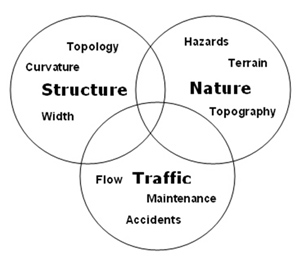
Typically, these vulnerabilities will occur on a collective basis, rather than on a one-by-one basis. Even though a particular stretch of road may be susceptible to only one of the aforementioned vulnerabilities, the overall network will be exposed to the full set of all vulnerabilities, some acerbating the other (figure 2 above). It is the collective sum of these vulnerabilities that needs to be addressed. Some links may exhibit structural deficiencies, some will be at the mercy of nature, and others are particularly vulnerable to traffic-generated incidents. Hence, a vulnerability analysis must consider each attribute separately, and, at the same time, as a whole.
In addition to the three categories listed above, a fourth dimension should be mentioned: the vulnerability towards an intentional terrorist attack, since an attacker will seek to exploit the vulnerabilities that are present in the network.
In essence, a vulnerability analysis must answer the three following questions, but not necessarily in the order mentioned: First, Vulnerable…where? to assess the location. Second, Vulnerable…to what? to assess the particular circumstances. Third, Vulnerable…how? to address the particular scenario and its impact.
VULNERABILITY AND RISK
Vulnerability and risk and are related concepts (15). An often used definition of risk is risk as being the product of consequence and probability. This equation can be extended to include vulnerability, such that vulnerability is as a factor that contributes to lessening or increasing the risk:
R = V(ec) x P(ec)
V = The vulnerability to the occurrence of an external circumstance (ec) or threat
P = The probability of the occurrence of an external circumstance (ec) or threat
One important point with respect to terrorist threats is that, while other threats can be expected to occur in a somewhat random and stochastically predictable fashion, terrorist threats are less predictable and somewhat endogenous (in the sense that the threat is likely to be greater if the vulnerability is greater, whereas with natural threats the probability of threat and the vulnerability to the threat can be assumed to be independent of one another). In terms of risk management, one usually distinguishes between two distinct strategies, one aimed at reducing the probability of an incident occurring and the second aimed at reducing the consequences of an incident that occurs, reflecting back towards the earlier definition of risk.
Applying this notion to the reliability and vulnerability of a road network, the aforementioned strategies would be aimed at a) reducing the probability of a disruption, known as pre-emptive measures, and b) reducing the consequences of a disruption, known as mitigative measures.
VULNERABILITY/RELIABILITY AND COST/BENEFIT
With the subject of vulnerability being open to a wide range of research approaches, it is not surprising that the vulnerability of transportation networks lacks a consensus definition. What should not be dissented from though, is that any vulnerability carries with it a cost to society, not only to the road users. The purpose of a cost-benefit analysis is to weigh the costs of a proposed project against the benefits of the project (16)(17)(18). If the benefits exceed the costs, then the project increases society’s welfare. If the costs exceed the benefits, society will experience a loss of welfare. The argument of vulnerability versus reliability is analogous: Any vulnerability of the transportation system causes disruptions that cause costs, which are a loss of welfare; vulnerability is thus a cost that is quantifiable. If society puts measures in place to reduce the vulnerability of the transportation network, the increased reliability represents a benefit.
In terms of road user utility new projects are generally considered as improvements, the same normally applies to reliability. It is often taken for granted that road improvements that alleviate congestion and travel time variability also improve reliability. What remains an open-ended question is whether new projects also bring with them a lesser vulnerability. Exchanging one kind of vulnerability for the other, while supposedly increasing reliability, may in terms of socio-economic impact not be the best solution.
A system approach that takes both sides into account is thus necessary. The reason is straightforward: to evaluate the cost of remaining vulnerable against the assumed benefit of becoming less vulnerable with the proposed project. Vulnerability, represented by the consequential costs of an operational degradation, is a cost that should be included in a cost-benefit analysis. Likewise, reliability, representing the consequential benefits of an operational improvement, is a benefit value, which too needs to be included. Today’s project evaluation practice looks almost exclusively at the construction costs on one hand, and the road user utility as the benefit on the other hand, with little or no notion of reliability or vulnerability.
Example 1: A project is proposed to reduce the consequences of avalanches on a selected link on a given route, being one route of several alternative routes between a given origin and destination. This reduces the particular vulnerability of this link on this route. This improvement may cause motorists to transfer to this route from the alternative routes. If some remaining vulnerabilities on other (non-improved) links along the now partially improved route are neglected and left unattended, then this may in turn affect a larger number of road users then before the particular improvement.
Example 2: Typical Norwegian issues of vulnerable links are ferry crossings, with a high probability of frequent closures and delays, often being the only access to a given community or between major regions. These crossings are in some cases replaced by sub sea tunnels, with practically no probability of any closure, and are hence considered a considerable improvement in reliability. Normally, after the tunnel is built, the ferry jetties are dismantled. If the tunnel is then closed due to an accident, say, a fire, and remains closed for a long period of time, this community would in fact be more vulnerable after the project then before.
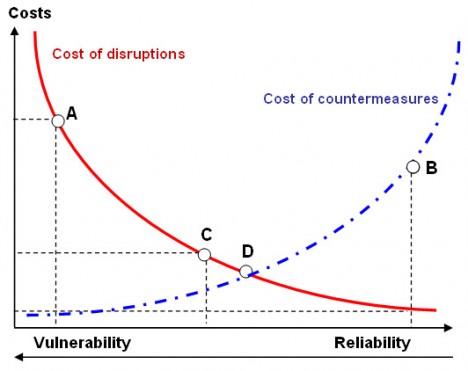
Figure 3 illustrates the relationship between vulnerability and reliability. The investment costs, and hence the assumed reliability, and thus, increase from left to right (dotted line), disruptions costs, and thus vulnerability, increase from right to left (solid line). From a strictly economical point of view, the cost of increasing the reliability should not exceed the cost of vulnerability for society to experience a benefit.
What is apparent is that it may be straightforward to quantify the investment costs associated with an effort to increase reliability, the costs of disruptions are much harder to quantify in measurable terms, albeit it can be done. The investment costs are included as a cost in cost-benefit analyses; however, saved disruption costs are not included as a benefit. Consequently, a proposed investment is not valued correctly, if saved disruption costs are not properly accounted for. The question that arises is whether saved disruption costs represent a utility similar to saved travel costs.
Example 3: To keep a mountain road open during winter one may consider improving the road by building a tunnel, more snow sheds, or aligning the road differently to alleviate weather exposure, or alternatively, invest in better snow-clearing equipment and increase clearing frequency. Today’s situation is (A), with high disruption costs. Building a new road and/or a tunnel is costly (B), but the probability of disruptions is lessened considerably and the disruption costs are almost negligible. Better snow-clearing equipment (C) reduces the susceptibility to disruptions somewhat – the road is still exposed to severe weather conditions – but the investment costs are much lower than in the former alternative. Consider which alternative is the most beneficial to society if investment costs and saved disruption cost are weighed against each other?
Note point (D) where the two curves intersect. The expected cost of disruptions (or the expected benefits of avoiding disruptions) is there equal to the cost of countermeasures. D is the socio-economically optimal level of expected disruption costs (and the optimal expenditure on countermeasures). A movement towards D from the left means that it will be cost-effective to implement a countermeasure. A movement from D to the right means that society will be better off “living with the vulnerability”. In this particular case, better snow-clearing equipment will be a good countermeasure, a new road/tunnel will not. The individual road user may of course disagree here, but from an overall cost-benefit perspective it is correct.
VULNERABILITY AND MULTI-CRITERIA ANALYSIS
According to (6), the transportation sector in general has very limited experience with regard to risk based management, and that especially thought processes on acceptable risk and the use of acceptance criteria is not fully developed. Cost-benefit analyses and environmental impact analyses are being used, but risk analyses and risk acceptance criteria are not really used. Risk as a concept and as a management tool has no marked tradition among the Norwegian road authorities or even amongst the international road authorities. With vulnerability inextricably linked to risk, a similar argument can be made with regard to vulnerability based management.
Some of the elements that project evaluation procedures should take explicitly into account in order to incorporate considerations of vulnerability are the following:
1. The probability and impact of failure of a given network, link or route, given various external circumstances or strenuous conditions
2. The probability of those external circumstances occurring
3. The robustness of the system (i.e., the probability that the system will continue to function even if a threat eventuates at a vulnerable point)
4. How long it will take (and how expensive it will be) to repair the system if the threat occurs and the system fails at its vulnerable point
5. What the costs are to the general economy of such a failure (i.e., goods and passengers not getting to their destinations, or getting there late, transportation carriers being forced to use expensive detours, etc.)
6. The contribution of a given project to improving the robustness (and hence reliability) of the system
7. What degree of risk aversion that should be applied in deciding what weight to place on the risk (i.e., level of threat times vulnerability) that has been identified.
These considerations can be incorporated into the project evaluation process using a multi-criteria analysis for both monetary and non-monetary impacts.
Figure 4 illustrates how this can be done. Here, vulnerabilities are assessed by their effect or impact. The purpose of dividing vulnerabilities into individual effects or impacts is to assess which type of traffic that is most affected or which impacts that are most prominent. The figure shows some of the effects of a sudden and unforeseeable incident that leads to the closure of a link or route (19).

Note that the evaluation criteria and the increment values used in figure 4 are for illustration only. In this illustration, average annual daily traffic serves as the first criteria, to assess the number of users that is affected. Second, the waiting time or delay time, or the time it takes to drive the diversion is differentiated between light and heavy vehicles to roughly account for the difference in value of time for business and leisure trips. Third, perishable goods lose value if not delivered on time. Fourth, some business may experience a loss of profit, because important deliveries or shipments are not made. Fifth, combined with the other criteria, the time (and cost) of reconstruction of this particular link serves as an additional criteria. The number of evaluation criteria must be adapted to the scenario that is investigated. Evaluation categories A-Z are weighted on a 0-1 scale, such that the sum of the category weights equals 1. Each weight is multiplied with the impact value 1-5. With this approach it is possible to compare and evaluate a number of vulnerabilities and to find the most critical link or most vulnerable point according to the criteria used.
CONCLUSION
This paper has sought to bring together three fields of research: reliability and vulnerability, costs and benefits, and decision-making, with the rationale that the reliability or vulnerability of the transportation network only seldom is looked at as a decision parameter in cost-benefit analyses, especially for new projects.
This paper has advocated that reliability and vulnerability should be part of the project evaluation in road development projects, and that reliability and vulnerability should be accounted for in cost-benefit analyses of said projects. A solid decision-making process should include a cost-benefit evaluation, but decisions related to vulnerability must pass a scrupulous review before they can be executed. Presentations of consequences should serve to highlight the issues that are at stake; these should not merely be synthesized into measures of gains and losses (20).
Socio-economic calculations and multi-criteria evaluations can assist in addressing the individual effects of vulnerability and reliability in the road network. In the end, the evaluation criteria, the factors, the constraints, the individual weighting and the decision rules are at the discretion of the decision-maker, and by including reliability and vulnerability as one element in the decision-making process it is possible to evaluate the cost of remaining vulnerable against the assumed benefit of becoming less vulnerable with the proposed project.
Finally, it must be said that the aim of this paper was not to find a justifiable measure of vulnerability, but to point at vulnerability as a variable that needs to be taken account of in cost-benefit analyses and in the evaluation of transportation networks. Therefore, in its composition, this paper has likely raised more questions than provided solid answers. It remains to bee seen, then, whether vulnerability and reliability will be a driving force in cost-benefit analyses of future road development projects.
REFERENCES
1. Husdal, J. (2004) Pålitelighet og sårbarhet – et ikke-tema i nyttekostanalyser? Samferdsel 2/2004, s. 28-30. Reliability and vulnerability – a non-issue in cost-benefit analyses? Samferdsel (Journal of the Norwegian Institute for Transport Economics, TØI), 2/2004, pp. 28-30
2. Statens vegvesen (1995) Konsekvensanalyser: Del 1, Prinsipper og metodegrunnlag. Håndbok 140. Vegdirektoratet. (Norwegian Public Roads Administration (1995) Impact analysis: Principles and methodology. Handbook 140.), Oslo, Norway.
3. Berdica, K. (2002) An introduction to road vulnerability: what has been done, is done and should be done. Transport Policy, Vol. 9, Iss. 2, pp. 117-127
4. Justisdepartementet (2001) Transportsikkerhet, i: NOU 2000:24 Et sårbart samfunn. (Norwegian Ministry of Justice (2001) Transportation Safety, in: NOU (Government Report) 2000:24 A vulnerable society.)
5. Hagen, J.M.; Rodal, G.H.; Hoff, E.; Lia, B.; Torp, J.E.; Gulichsen, S (2003) Beskyttelse av samfunnet med fokus på transportsektoren. FFI/Rapport 2003/00929. Forsvarets Forskningsinstitutt, Kjeller, Norge. Protecting the society, focusing on the transport system. FFI/Report 2003/00929. Norwegian Defence Research Establishment, Kjeller, Norway.
6. RISIT (2004) RISIT – Risk and safety in the transport sector – A state-of-the-art review of current knowledge. White paper. The Research Council of Norway.Adler, H.A. (1987) Economic Appraisal of Transport Projects. Johns Hopkins University Press.
7. Taylor, M. A. P. and D’Este, G.M.D. (2003a) Network Vulnerability: An Approach to Reliability Analysis at the Level of National Strategic Transport Networks. In: The Network Reliability of Transport, eds. M.G.H. Bell and Y. Iida, Proceedings of the 1st International Symposium on Transportation Network Reliability, pp.23-44. Elsevier Science, Kidlington.
8. Taylor, M. A. P. and D’Este, G.M.D. (2003b) Concepts of network vulnerability and applications to the identification of critical elements of transport infrastructure. Paper presented at the 26th Australasian Transport Research Forum, Wellington, New Zealand, 1-3 October
9. Bell, M.G.H., Iida, Y. (1997) Network Reliability. In: Transportation Network Analysis, eds. M.G.H. Bell and Y Iida, pp.179-192, John Wiley & Sons, Chichester.
10. Nicholson, A.; Schmöcker, J.-D.; Bell, M.G.H. and Iida, Y (2003) Assessing Transport Reliability: Malevolence and User Knowledge. In: The Network Reliability of Transport, eds. M.G.H. Bell and Y. Iida, Proceedings of the 1st International Symposium on Transportation Network Reliability, pp.1-22. Elsevier Science, Kidlington.
11. Dalziell, E.; Nicholson, A.J. (2001) Risk and impact of natural hazards on a road network. Journal of Transportation Engineering, 127(2), pp. 159-166.
12. LLeras-Echeverri, G. and Sanchez-Silva, M. (2001) Vulnerability analysis of highway networks, methodology and case study. Transport 174 (4), pp.223-230.
13. Srinivasan, K, (2002) Transportation Network Vulnerability Assessment: A quantitative framework. Transportation Security Papers 2002. White paper, Vanderbilt University/ Southeastern Transportation Center.
14. Husdal, J (2004) Reliability/vulnerability versus Costs/Benefits. Proceedings of the 2nd International Symposium on Transportation Network Reliability, Queenstown and Christchurch, New Zealand, 20-24 August 2004, p. 180-186.
15. Cova, T.J., and Conger, S. (2004) Transportation hazards, In: Handbook of Transportation Engineering, ed. M. Kutz, pp. 17.1-17.24, McGraw Hill, New York
16. Adler, H.A. (1987) Economic Appraisal of Transport Projects. Johns Hopkins University Press.
17. Nas, T. (1996) Cost-Benefit Analysis, Theory and Applications. Sage Publications
18. McHarg, I (1967) Where should Highways go? Landscape Architecture, 57, pp. 179-181
19. Bråthen, S and Lægran, S (2004) Bottlenecks in Road Freight Transport in Norway (Norwegian). Project report no. 245701,. Sweco Grøner, Oslo, Norway
20. Aven, T and Kørte, J. (2003) On the use of risk and decision analysis to support decision-making. Reliability Engineering and System Safety, 79, pp. 289-299
REFERENCE
Husdal, J. (2005) The vulnerability of road networks in a cost-benefit perspective. Paper presented at TRB2005, the Transportation Research Board Annual Meeting 2005, Washington DC, USA, 9-13 January 2005.
READ ONLINE
RELATED
- husdal.com:
The reliability and vulnerability of transportation lifelines - husdal.com:
Reliability and vulnerability – a non-issue in cost-benefit analyses? - husdal.com:
Reliability and vulnerability versus costs and benefits (INSTR2004) - husdal.com:
Reliability and vulnerability versus costs and benefits (ETC2004) - husdal.com:
Transport network vulnerability – which metrics should we use? (NECTAR2006) - husdal.com:
Are roads more important than computers?


